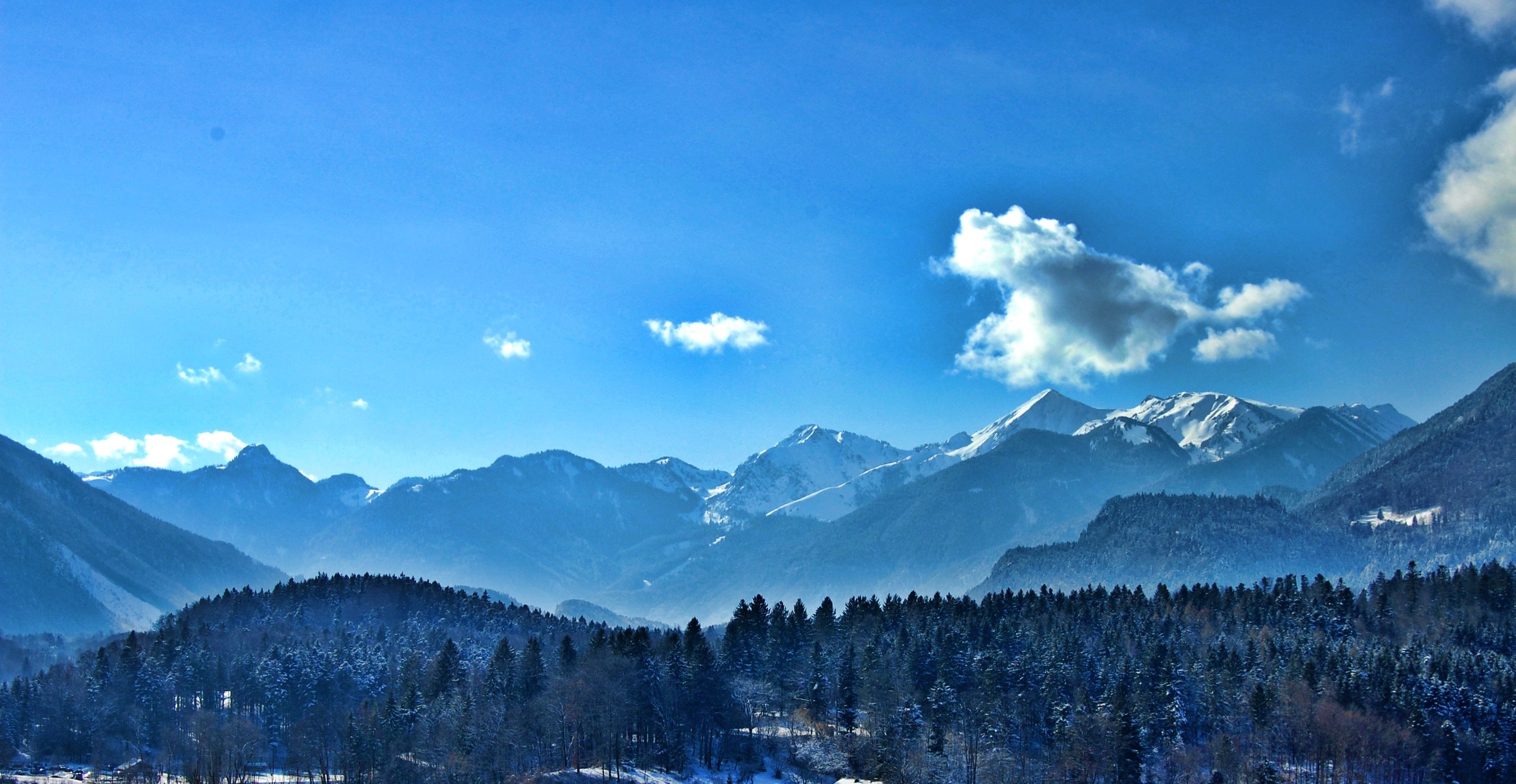
Thanks to the film “2001 a Space Odyssey,” “Thus Spoke Zarathustra” by Richard Strauss is one of the most recognizable pieces of classical music on the planet.
That was one of the most effective uses of music in the history of film making.

Zoroaster on mirrored etched glass
This is a long form post in 3 parts. My suggestion, check out the photos in part 2 and come back later for parts 1 & 2.

First things first – Zoroaster (Zarathustra)
Although this post is only tangentially connected to Zarathustra, it's worth mentioning that he is an immensely interesting and influential historical figure. There is considerable debate about when he actually lived, a consensus estimate is somewhere between 1500 BC and 500 BC; however, the some of the classical Greek historians believed he lived over 6,000 years BC (ancient astronaut theorists agree :-) In any case, the Persian prophet Zarathustra (Zoroaster) was ranked first in the chronology of philosophers by the Oxford Dictionary of Philosophy.
Europeans had looked to ancient Greece as the birthplace of art, science, and philosophy, but eventually discovered that Zarathustra had significantly influenced them, as well as Judaism, Christianity, and Islam. Goethe, for example, became utterly captivated Persian culture. Nietzsche used Zoroaster, for much different reasons, in his philosophical novel “Also Sprach Zarathustra.” Richard Strauss composed a symphonic poem which was inspired by Friedrich Nietzsche's novel. In any case, Zoroaster could be the subject for an interesting post for some intrepid Steemarian.
 Obwohl dieser Post nur tangential mit Zarathustra zu tun hat, ist es erwähnenswert, dass er eine immens interessante und einflussreiche historische Figur war. Es gibt eine beträchtliche Debatte darüber, wann er tatsächlich lebte, eine Konsensschätzung liegt zwischen 1500 und 500 v. Chr. Allerdings gab es einige der klassischen Griechen die glaubten, dass er über 6.000 Jahre v. Chr. gelebt hat. Auf jeden Fall, der persische Prophet Zarathustra (Zoroaster) wurde vom Oxford Dictionary of Philosophy als erster in der Chronologie der Philosophen genannt.
Obwohl dieser Post nur tangential mit Zarathustra zu tun hat, ist es erwähnenswert, dass er eine immens interessante und einflussreiche historische Figur war. Es gibt eine beträchtliche Debatte darüber, wann er tatsächlich lebte, eine Konsensschätzung liegt zwischen 1500 und 500 v. Chr. Allerdings gab es einige der klassischen Griechen die glaubten, dass er über 6.000 Jahre v. Chr. gelebt hat. Auf jeden Fall, der persische Prophet Zarathustra (Zoroaster) wurde vom Oxford Dictionary of Philosophy als erster in der Chronologie der Philosophen genannt.
Die Europäer hatten das antike Griechenland als Geburtsort von Kunst, Wissenschaft und Philosophie angesehen. Als sie von dem Einfluss von Zarathustra erfuhren, war es ein Überraschung. Goethe zum Beispiel war von der persischen Kultur völlig fasziniert. Nietzsche benutzte Zoroaster aus ganz anderen Gründen in seinem philosophischen Roman "Also Sprach Zarathustra." Richard Strauss symphonische Dichtung war von Friedrich Nietzsches Roman inspiriert. Auf jedem Fall wäre das Thema Zoroaster für eine interessante Post gut geeignet.
Clip -- Richard Strauss “Thus Spoke Zarathustra” from the Film “2001 a Space Odyssey”
After this unforgettable film, in typical Hollywood fashion this same music was exploited and degraded and in a number of subsequent movies: “Small Soldiers,” “Drop Dead Gorgeous,” “Toy Story 2,” “Magnolia,” “Man on the Moon,” “Spaceballs,” “Zoolander,” “Death to Smoochy,” “Harold and Kumar Go to White Castle,” “Charlie and the Chocolate Factory,” “Lords of Dogtown,” “The Simpsons Movie,” “Semi Pro,” “Turner & Hooch,” and “The Big Bus.” There was one notable exception, the Oscar winning film “Being There” which effectively used Deodato's popular jazz version of the music.
Coincidentally, the film “2001 a Space Odyssey”also featured “On the Beautiful Blue Danube,” a Waltz by Johann Strauss. It's uncanny that both pieces of music were perfectly suited for this film were composed by two composers named Strauss. Richard was a Bavarian, and Johann was an Austrian – they were not related. Not only that, but if you recall the film, “Thus Spoke Zarathustra” fades and transitions directly into “On the Beautiful Blue Danube.”

Eine bayerische Musik Odyssee – Also Sprach Zarathustra
Dank des Films "2001 a Space Odyssey" ist "Also Sprach Zarathustra" von Richard Strauss eines der bekanntesten Stücke der klassischen Musik auf diesem Planeten. Das war eine der effektivsten Anwendungen der Musik in der Geschichte des Filmemachens.
Im typischen Hollywood Stil wurde diese Musik dann ausgebeutet und in einer Reihe von Filmen, “Small Soldiers,” “Drop Dead Gorgeous,” “Toy Story 2,” “Magnolia,” “Man on the Moon,” “Spaceballs,” “Zoolander,” “Death to Smoochy,” “Harold and Kumar Go to White Castle,” “Charlie and the Chocolate Factory,” “Lords of Dogtown,” “The Simpsons Movie,” “Semi Pro,” “Turner & Hooch,” und “The Big Bus,“ degradiert. Es gab eine bemerkenswerte Ausnahme, den Oscar-prämierten Film"Being There", der Deodatos populären Jazz-Version der Musik verwendete.

The Home of Richard Strauss
Today I'm going to take you on a photo tour of the small Bavarian village where Richard Strauss composed much of his music, and after the photos I'll share a some thought about Steem/Steemit brought on by thinking about this composer from the past.
A 1,748 m (5,735ft) mountain named Hochgern (literally High-gladly) towers over our valley. From the summit looking toward the Northwest it affords a fantastic view of the Chiemsee, and toward the South a breathtaking panorama of the Austrian Alps. There is no lift on this mountain, so the only to the summit is on foot. The castle dates back to the 1100s and was restored in the mid 19th century. The building directly in front is now a bakery, but I asked the own about its history and she said it used to house a copper smith and is no doubt also quite old.
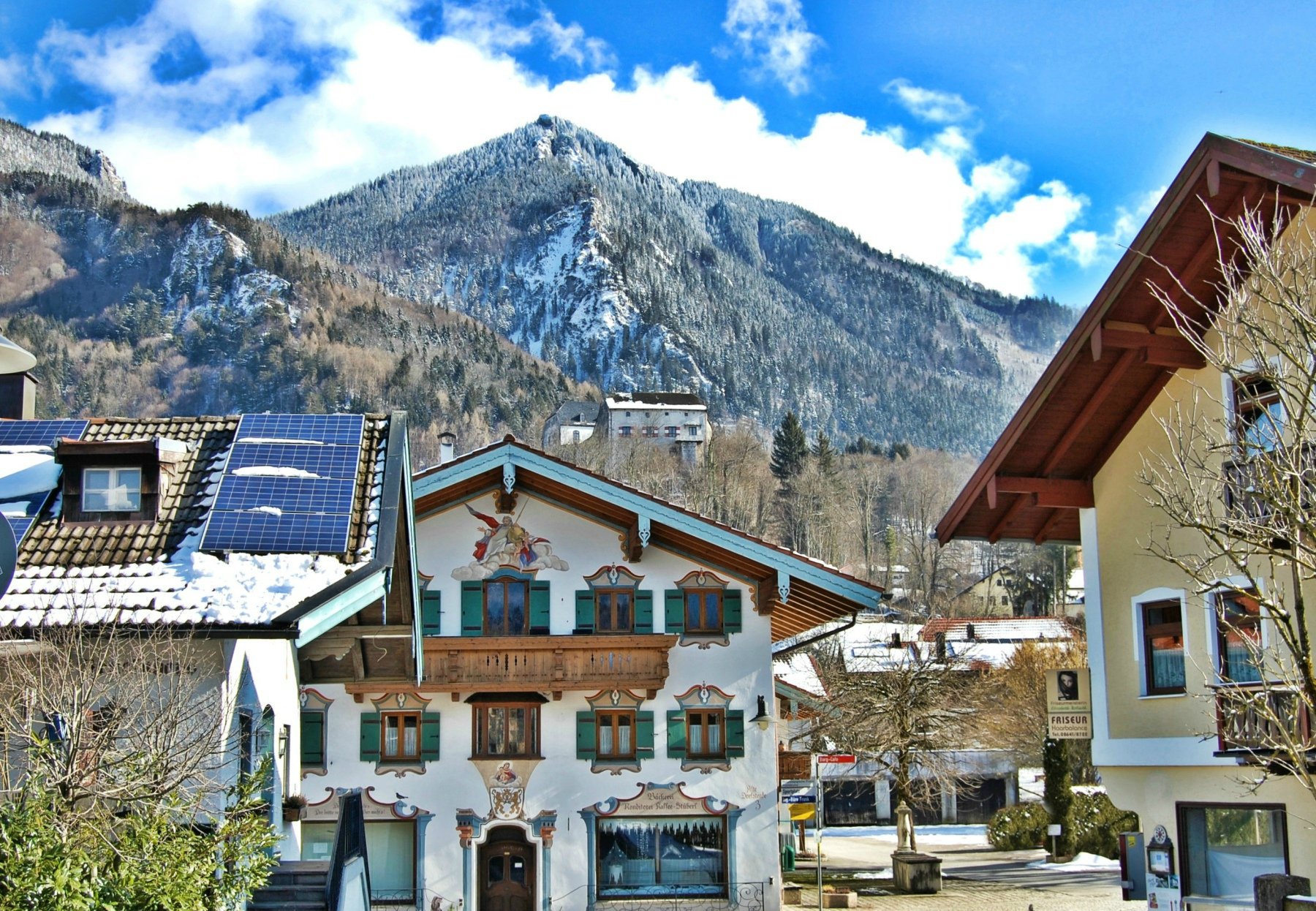
Heute werde ich euch auf eine Foto-Tour durch das kleine bayerische Dorf mitnehmen, wo Richard Strauss viel von seiner Musik komponierte. Danach auch ein paar Gedanken über Steem/Steemit.
Der 1.748 m hohe Hochgern überragt unser Tal. Vom Gipfel in Richtung Nordwesten bietet sich ein fantastischer Blick auf den Chiemsee und nach Süden ein atemberaubendes Panorama auf die österreichischen Alpen. Es gibt keinen Lift auf diesem Berg. Um den Ausblick zu erleben, muss man also zu Fuß zum Gipfel wandern. Das Schloss stammt aus dem 12. Jahrhundert und wurde Mitte des 19. Jahrhunderts restauriert. Das Gebäude direkt vor mir ist jetzt eine Bäckerei, aber ich habe die Besitzerin mal nach seiner Geschichte gefragt und sie sagte, dass es früher einen Kupferschmied beherbergte und zweifellos auch ziemlich alt ist.
Here we see the Hofwirth zur Post where the composer Richard Strauss was purportedly a frequent guest. This building also dates back to the 1100s and was beautifully restored about twenty years ago. Gasthaus zur Post is something you see often in Germany, and they are often large old buildings which take you back in time to a different era. (In this case "Hof" refers to the "Court" of the castle.) My guess is that these Post Guesthouses date back to a time before trains when people and mail were transported in “stage” coaches.
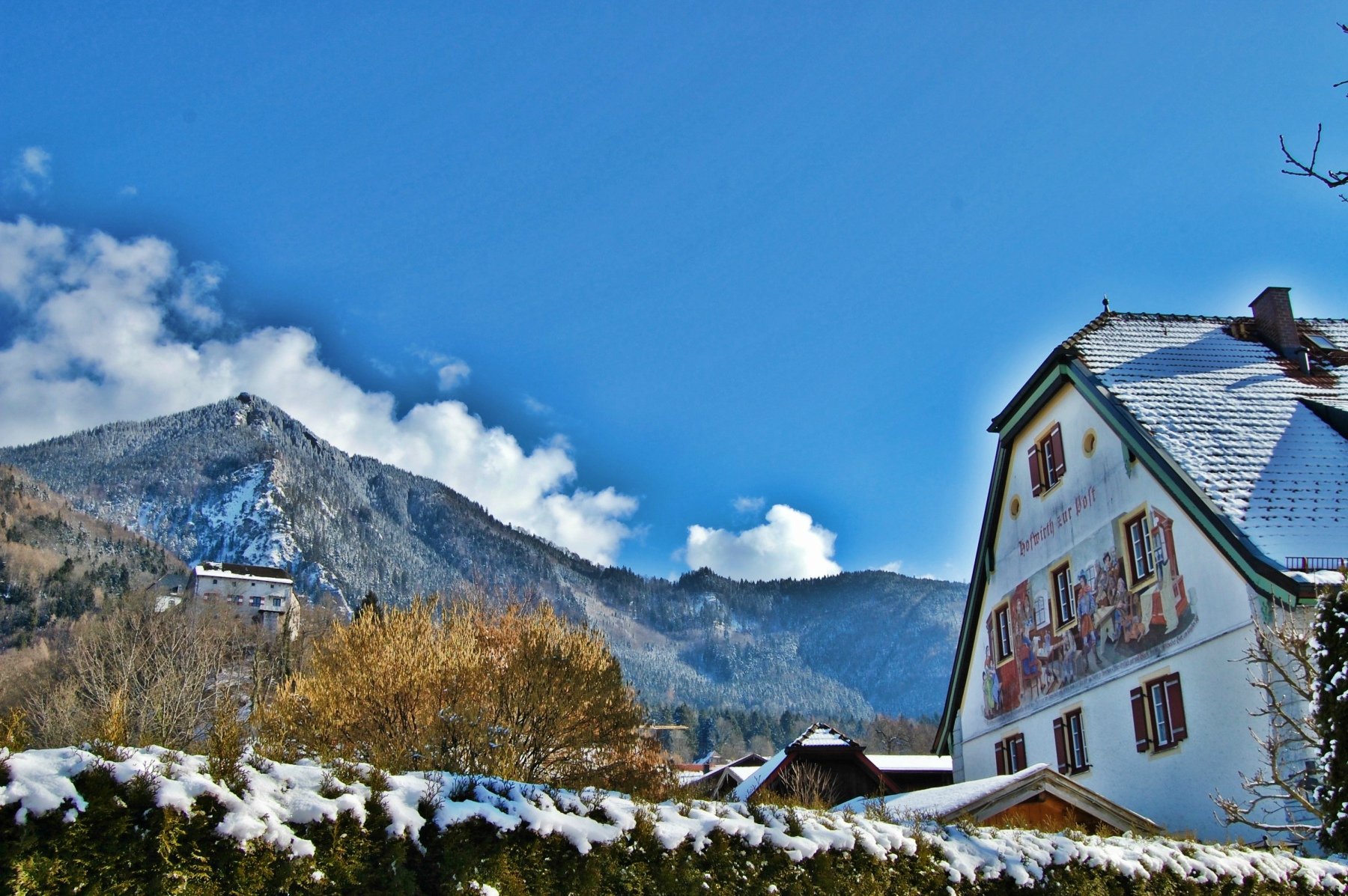 Hier sehen wir den Hofwirth zur Post, wo der Komponist Richard Strauss häufig zu Gast war. Dieses Gebäude stammt ebenfalls aus dem 12. Jahrhundert und wurde vor etwa zwanzig Jahren wunderschön restauriert. Das „Gasthaus zur Post“ ist in Deutschland ein sehr gebräuchlicher Name und oft sind es große, alte Gebäude, die einen in eine andere Zeit versetzen. Ich konnte keine Informationen über die Herkunft des Namens finden, aber ich vermute, dass es auf eine Zeit vor den Zügen zurückgeht, als Menschen und Post in Kutschen transportiert wurden.
Hier sehen wir den Hofwirth zur Post, wo der Komponist Richard Strauss häufig zu Gast war. Dieses Gebäude stammt ebenfalls aus dem 12. Jahrhundert und wurde vor etwa zwanzig Jahren wunderschön restauriert. Das „Gasthaus zur Post“ ist in Deutschland ein sehr gebräuchlicher Name und oft sind es große, alte Gebäude, die einen in eine andere Zeit versetzen. Ich konnte keine Informationen über die Herkunft des Namens finden, aber ich vermute, dass es auf eine Zeit vor den Zügen zurückgeht, als Menschen und Post in Kutschen transportiert wurden.
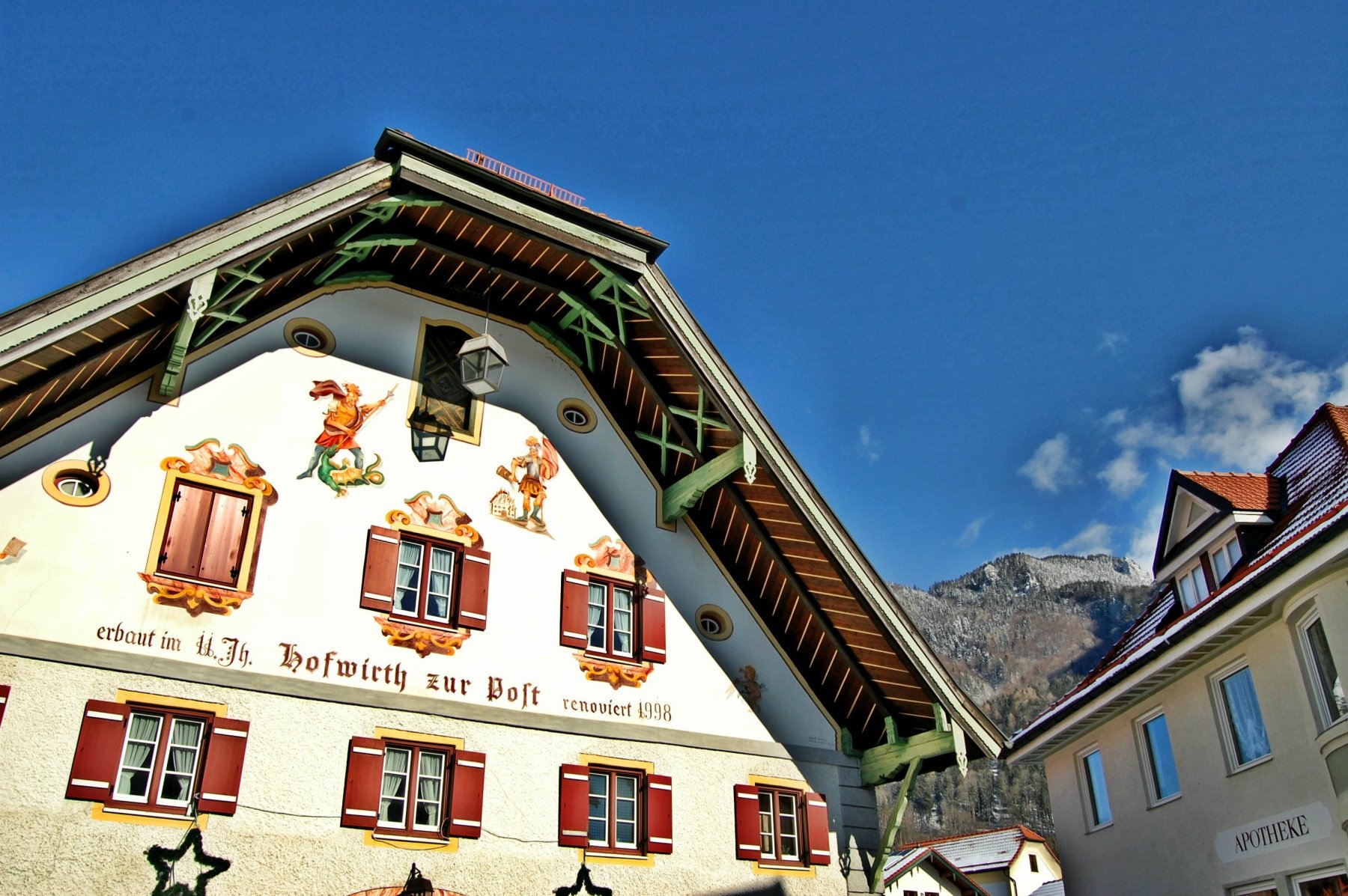
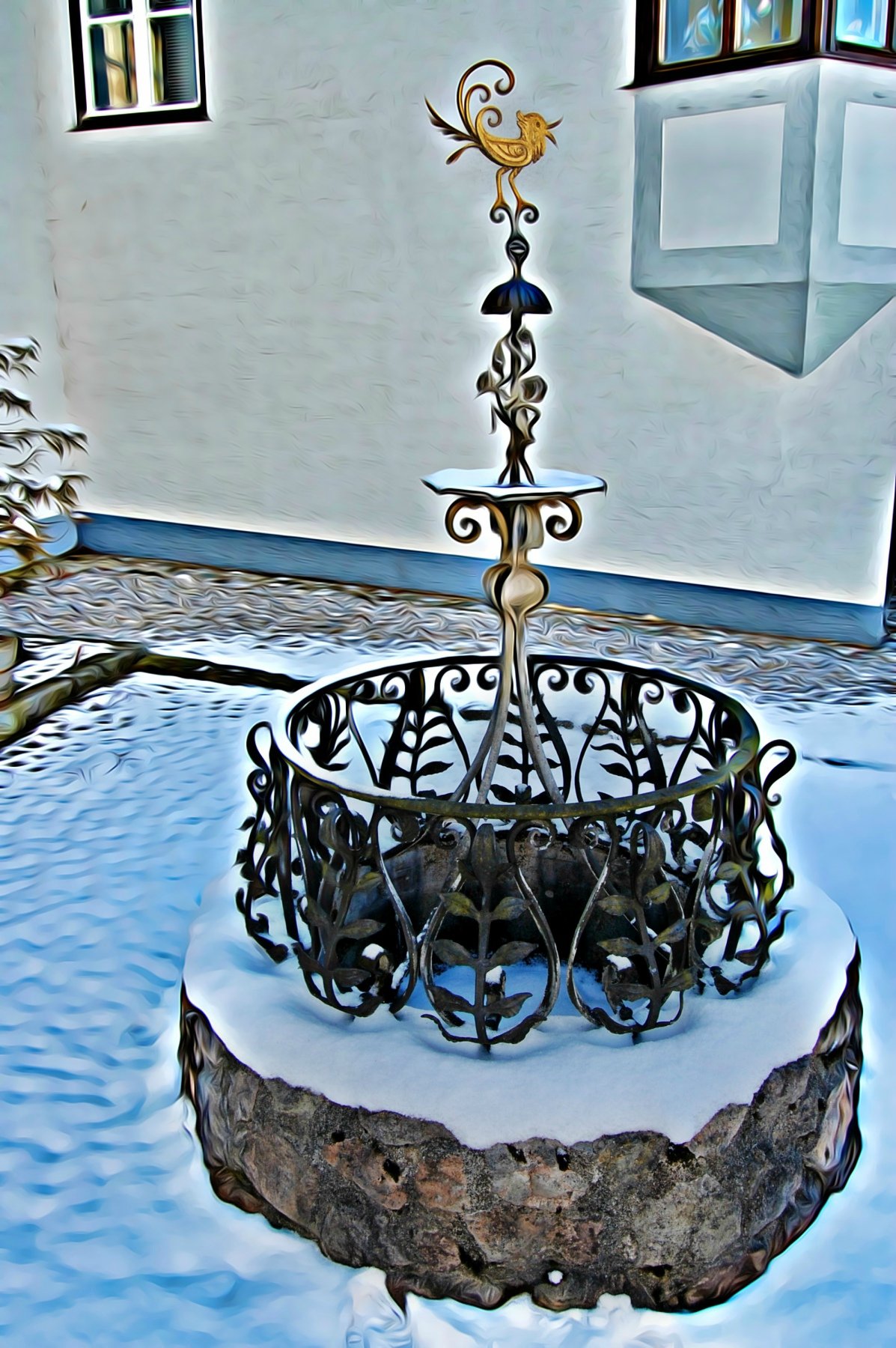

Rather than taking the street, this is a detour behind a farmer's house “Baurnhof” which gives us a nice view of the castle. This narrow building is what is referred to here as an “Austragshaus.” These are often stone buildings where a farmer lives after turning over the farm to his heirs. It's not uncommon for them to also have another function as well, for example storage.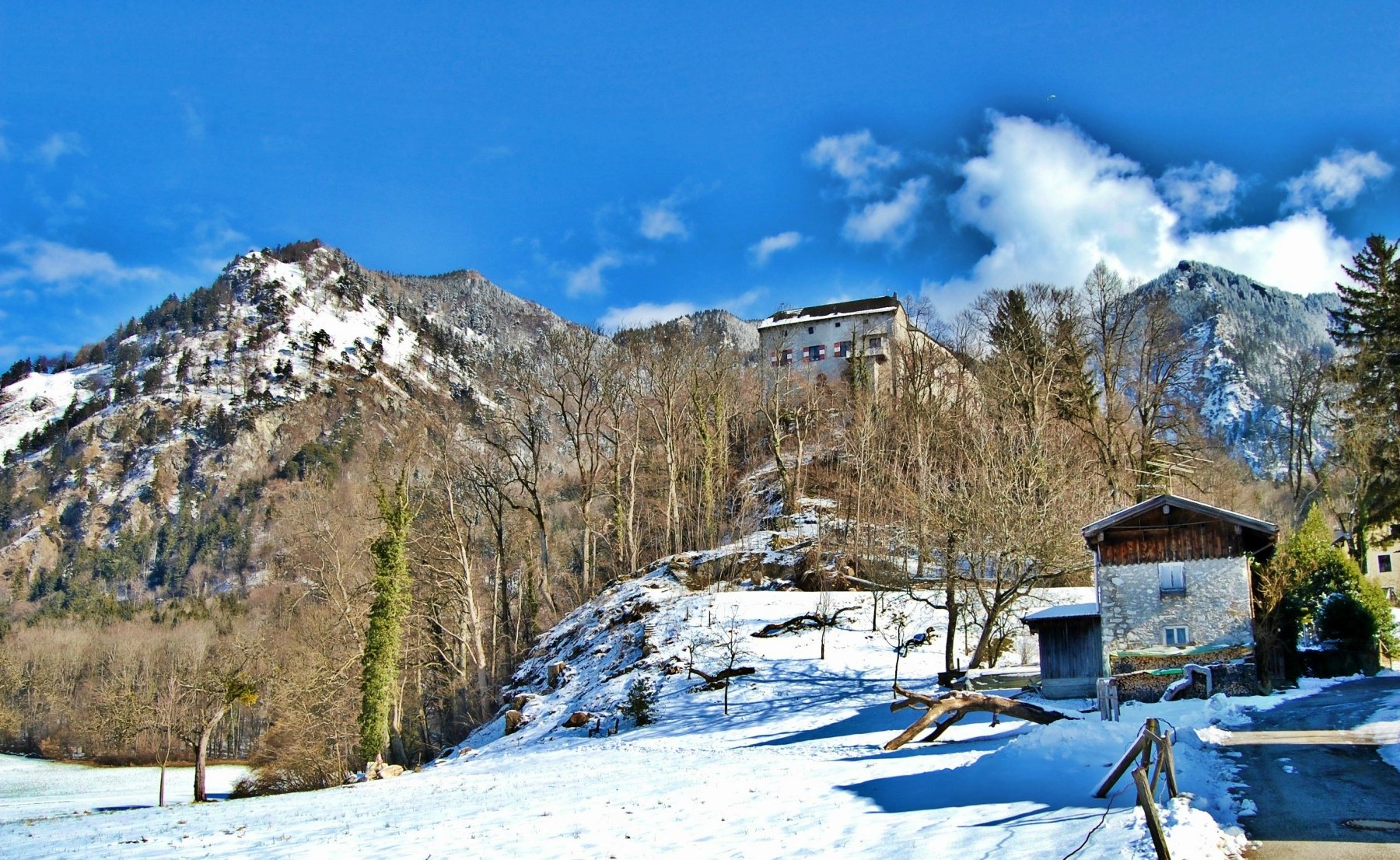 Anstatt die Straße zu nehmen, gehen wir einen Umweg hinter einen Bauernhof, von dem aus wir einen schönen Blick auf die Burg haben. Dieses schmale Gebäude nennt man hier ein "Austragshaus." Es sind oft Gebäude aus Natursteinen, in denen die Eltern leben, nachdem der Hof an die Erben übergeben wurde.
Anstatt die Straße zu nehmen, gehen wir einen Umweg hinter einen Bauernhof, von dem aus wir einen schönen Blick auf die Burg haben. Dieses schmale Gebäude nennt man hier ein "Austragshaus." Es sind oft Gebäude aus Natursteinen, in denen die Eltern leben, nachdem der Hof an die Erben übergeben wurde.
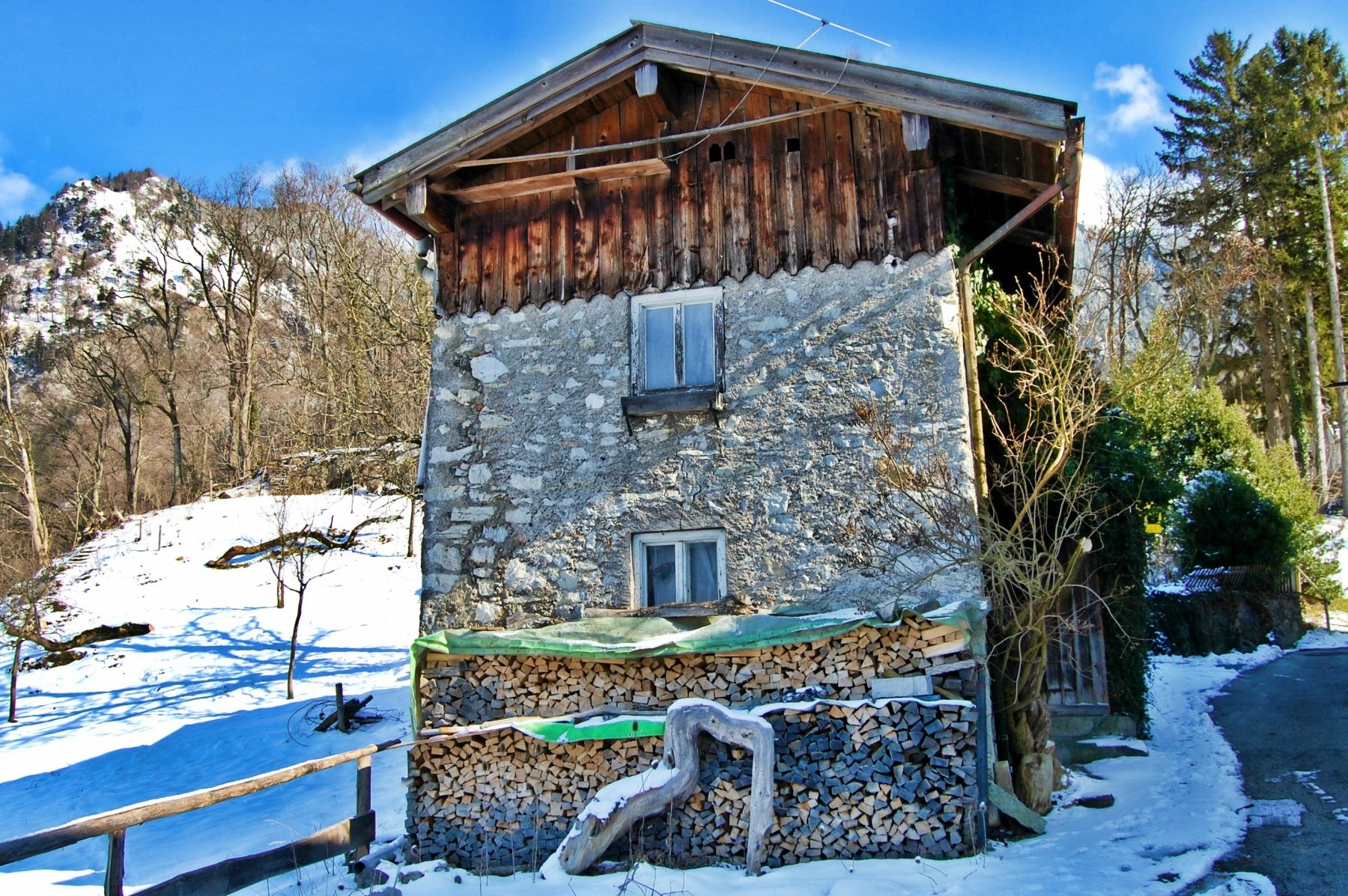
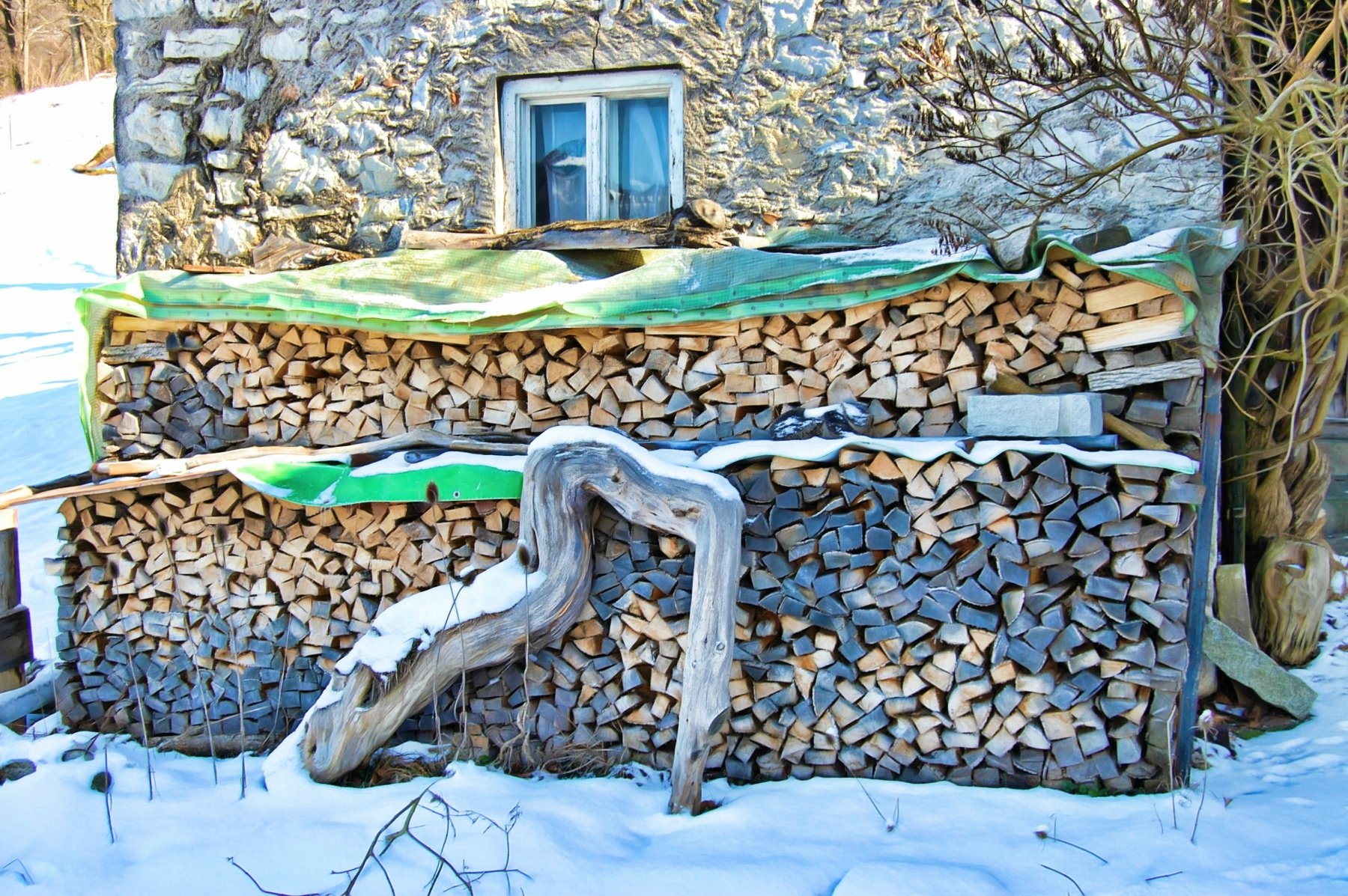 Now we take a right turn and return to the street to see the home of Richard Strauss (translation of plaque): Richard Strauss lived in this house from 1894 to 1907 and composed most of his songs, symphonic poems, as well as the operas “Feuersnot” and “Salome.”
Now we take a right turn and return to the street to see the home of Richard Strauss (translation of plaque): Richard Strauss lived in this house from 1894 to 1907 and composed most of his songs, symphonic poems, as well as the operas “Feuersnot” and “Salome.”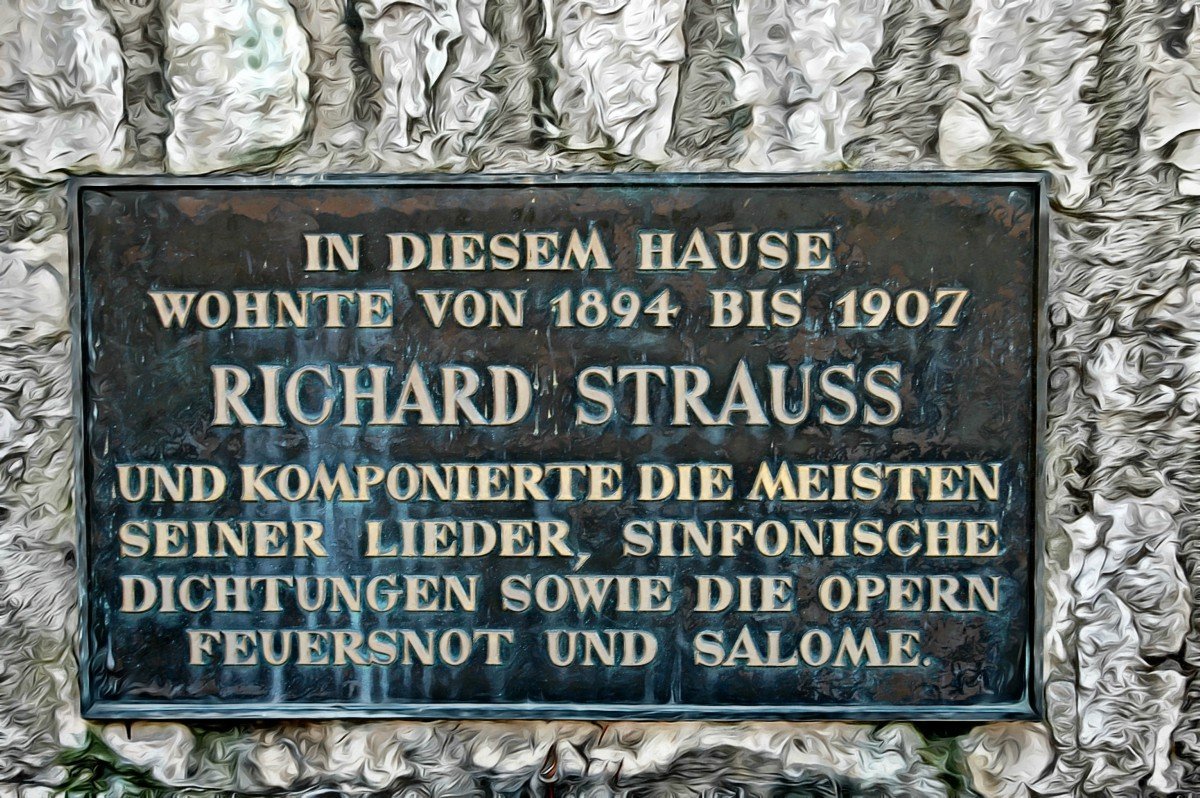
He was from Munich, but my understanding is that this house had been the summer residence of his wife's family. It is an idea location, elevated enough to be above the flood line, but conveniently close to the center of the village. 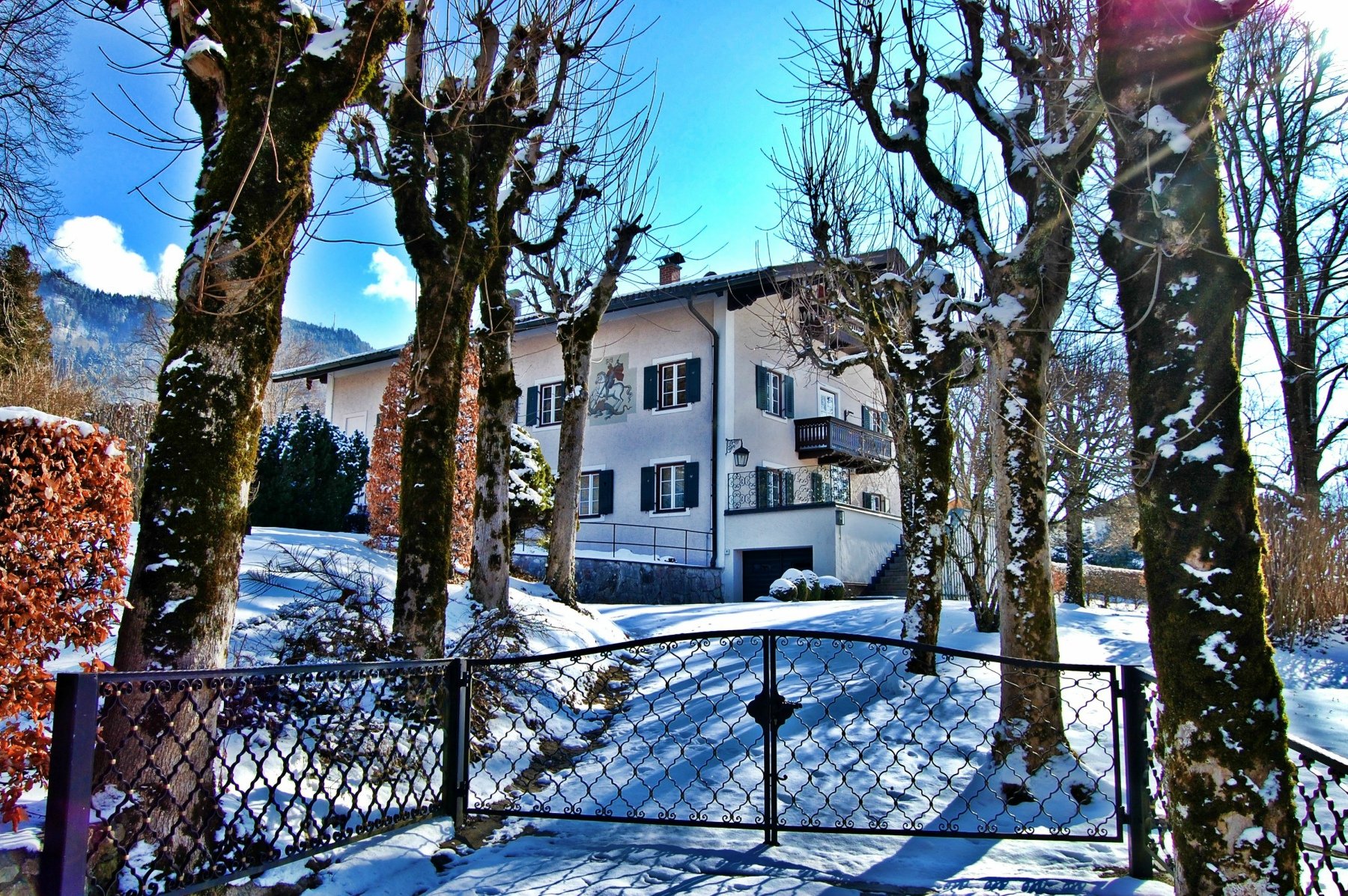 Er war aus München, aber nach meinem Verständnis war dieses Haus die Sommerresidenz der Familie seiner Frau gewesen. Es ist ein idealer Ort, hoch genug, um über der Flutlinie zu sein, aber nicht weit vom Dorfzentrum.
Er war aus München, aber nach meinem Verständnis war dieses Haus die Sommerresidenz der Familie seiner Frau gewesen. Es ist ein idealer Ort, hoch genug, um über der Flutlinie zu sein, aber nicht weit vom Dorfzentrum.
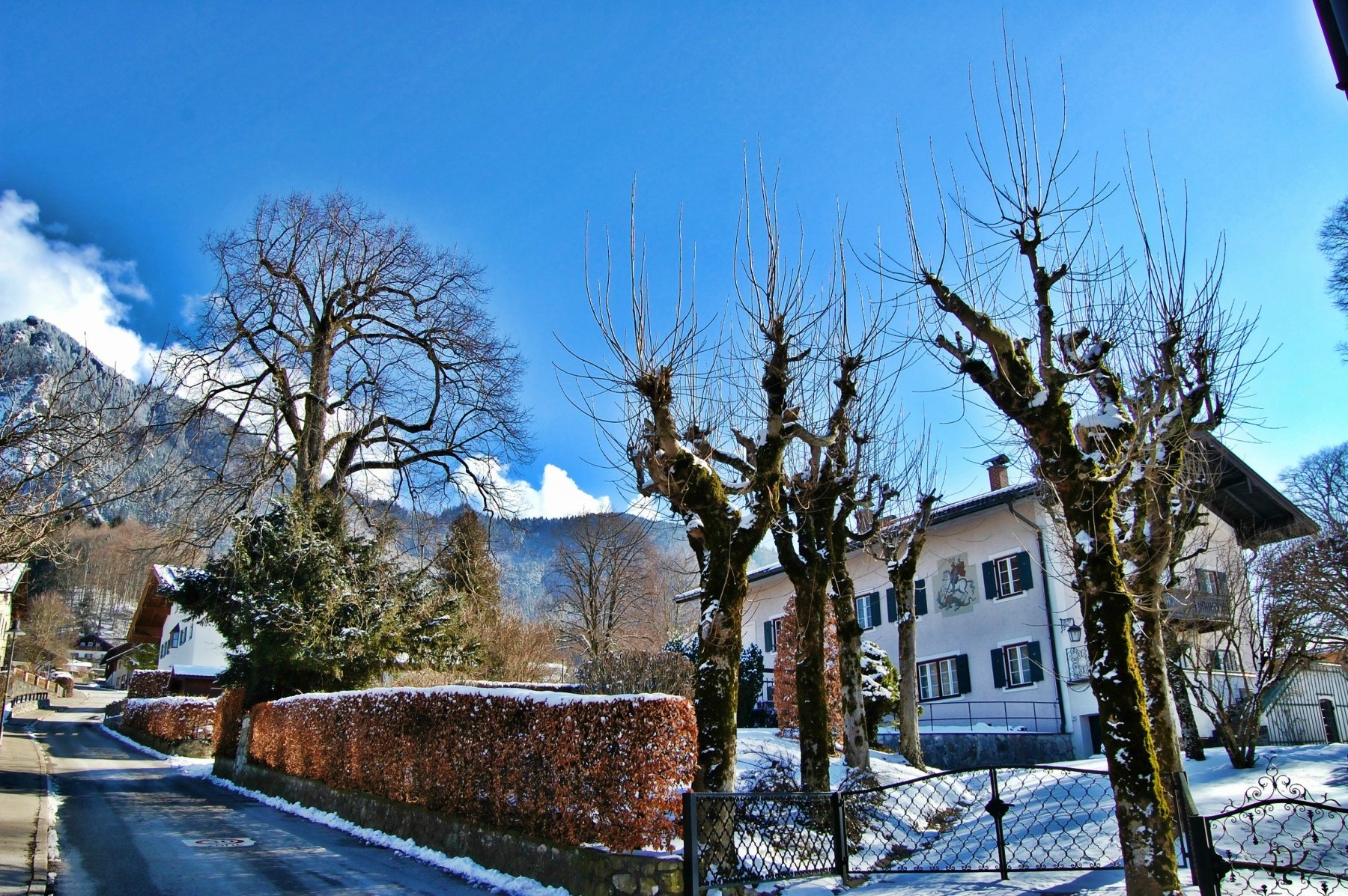

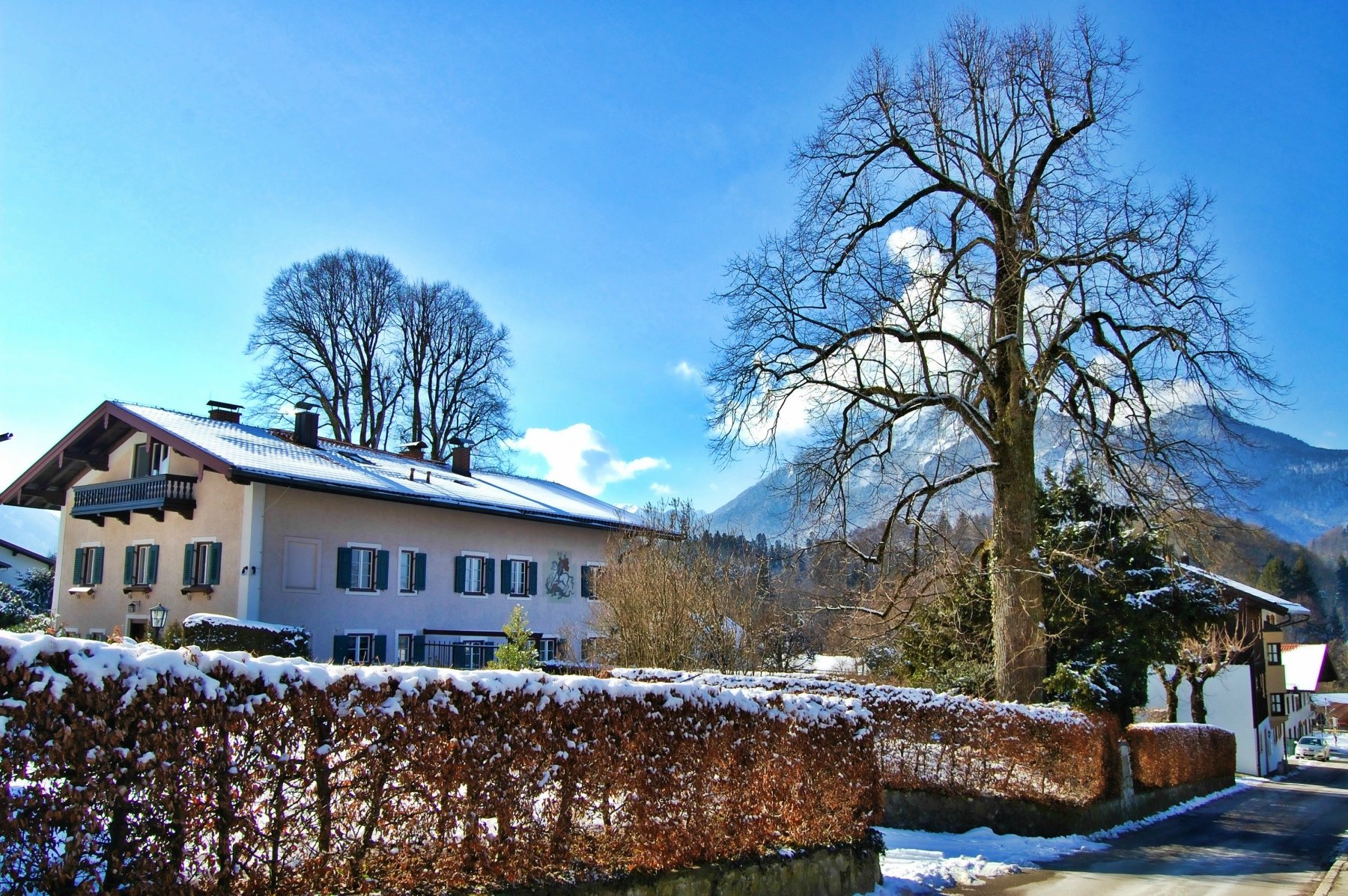 We're walking up the hill toward the castle.
We're walking up the hill toward the castle.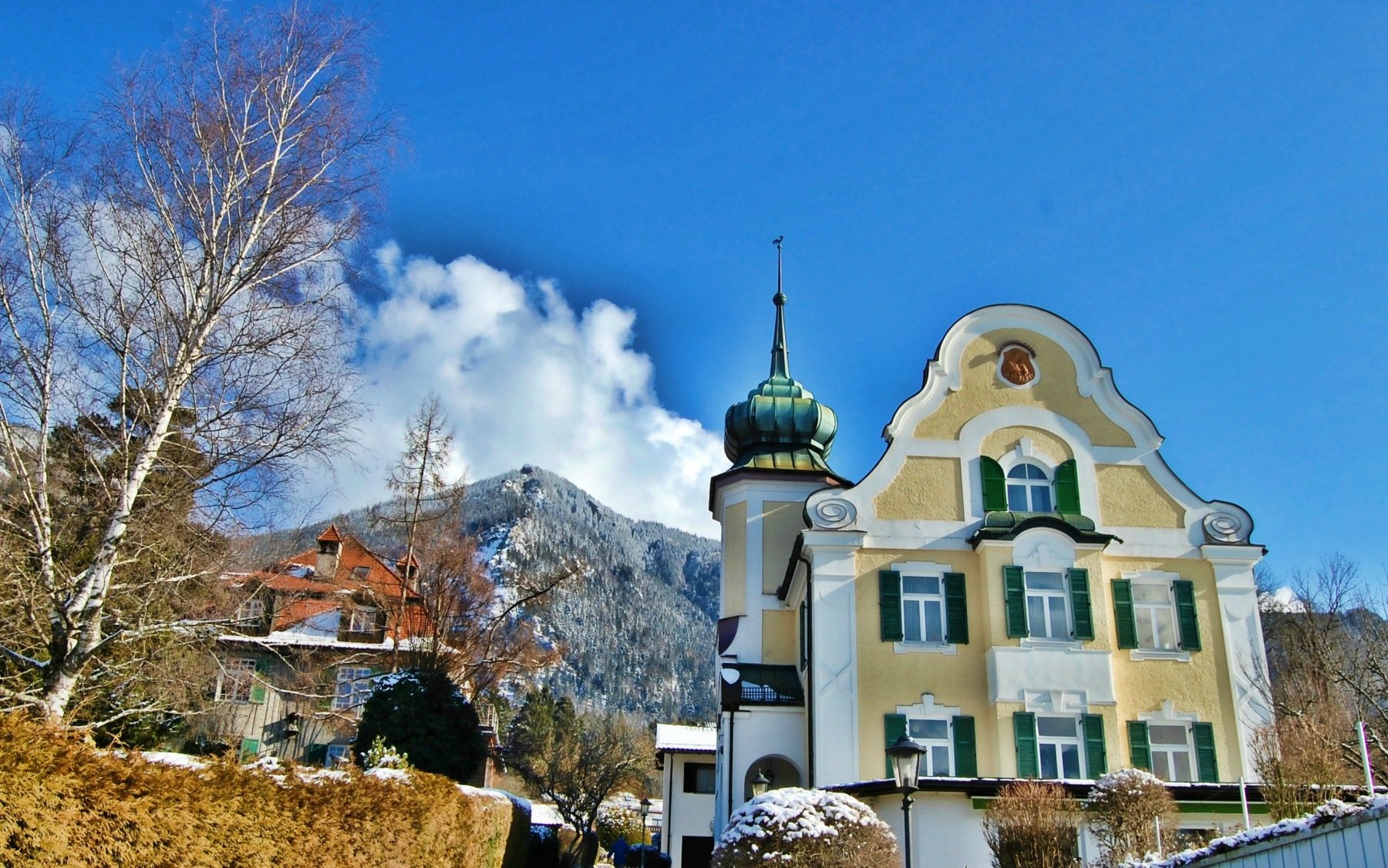 Wir gehen den Hügel hinauf zur Burg..
Wir gehen den Hügel hinauf zur Burg..
Although this isn't an attractive building or photo, it's only truly visible in winter. The castle has 40 bedrooms and went on sale in 2015 through Sotheby's for an undisclosed price.
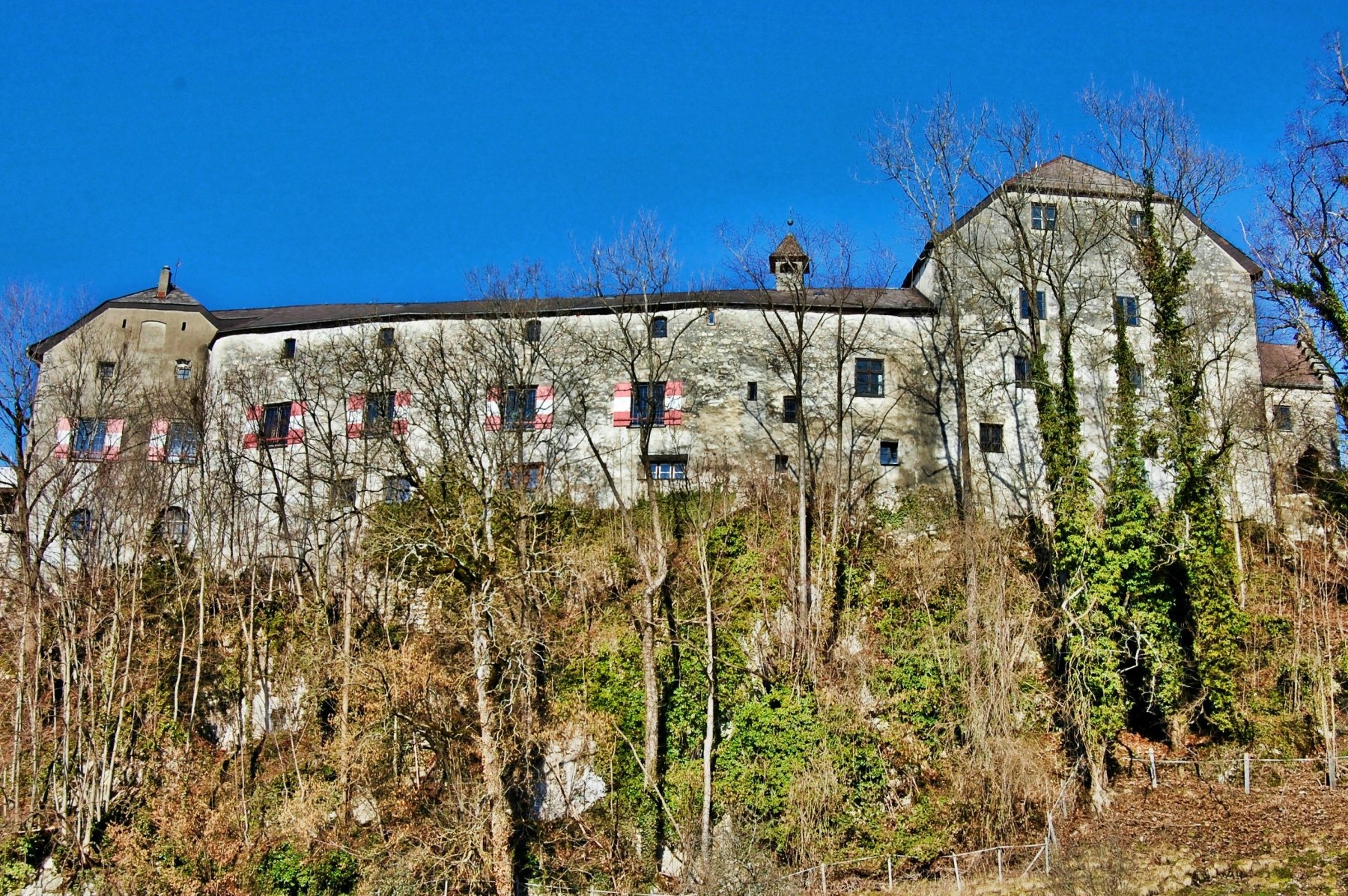 Obwohl dies kein besonders attraktives Gebäude oder Foto ist, ist es nur im Winter so sichtbar. Die Burg verfügt über 40 Schlafzimmer und wurde 2015 von Sotheby's zu einem nicht genannten Preis verkauft.
Obwohl dies kein besonders attraktives Gebäude oder Foto ist, ist es nur im Winter so sichtbar. Die Burg verfügt über 40 Schlafzimmer und wurde 2015 von Sotheby's zu einem nicht genannten Preis verkauft.
On the footpath leading to the castle. 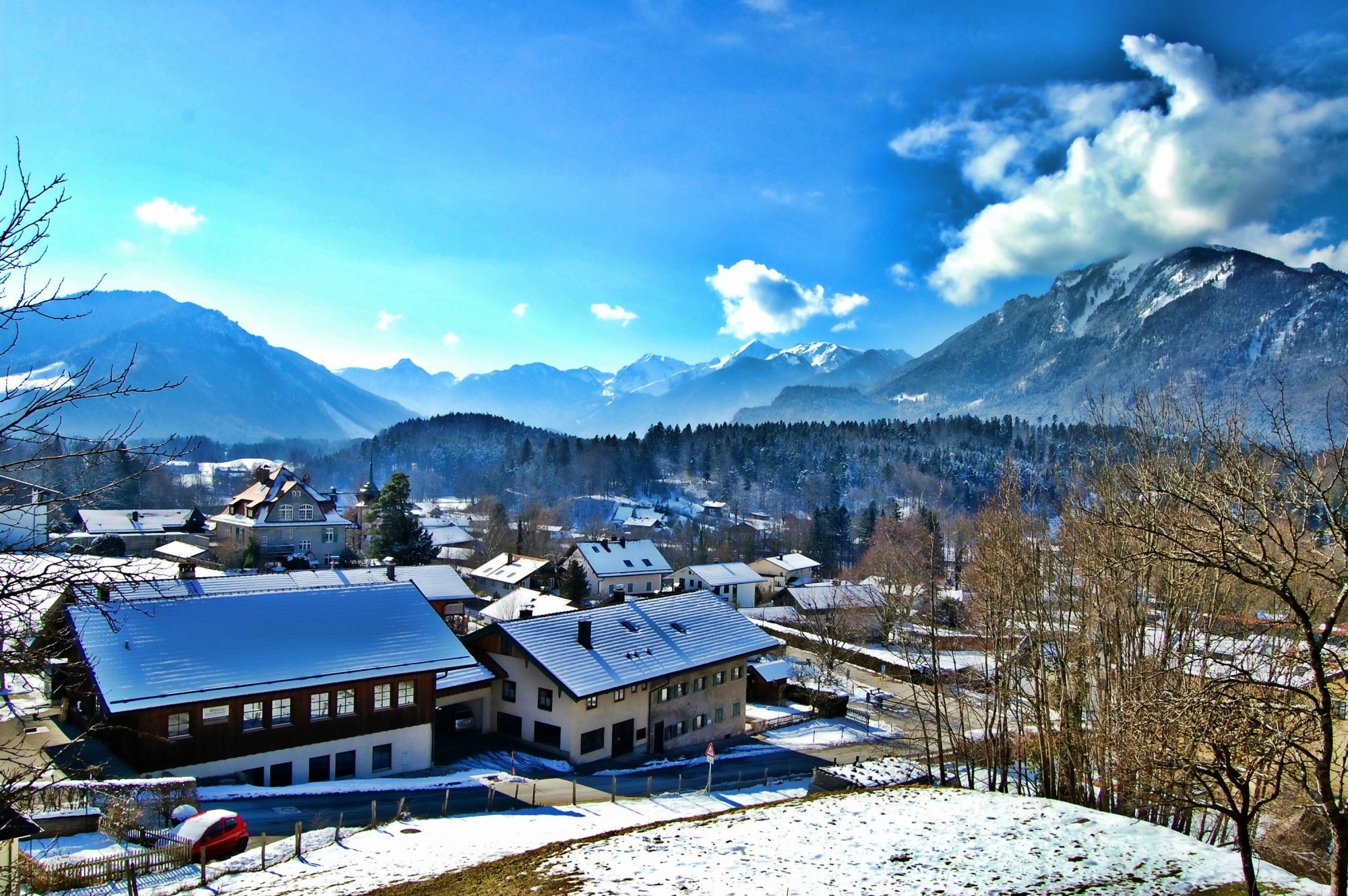 Auf dem Fußweg zur Burg.
Auf dem Fußweg zur Burg.
Close up of the German Alps  Nahaufnahme der deutschen Alpen
Nahaufnahme der deutschen Alpen
Now facing the castle.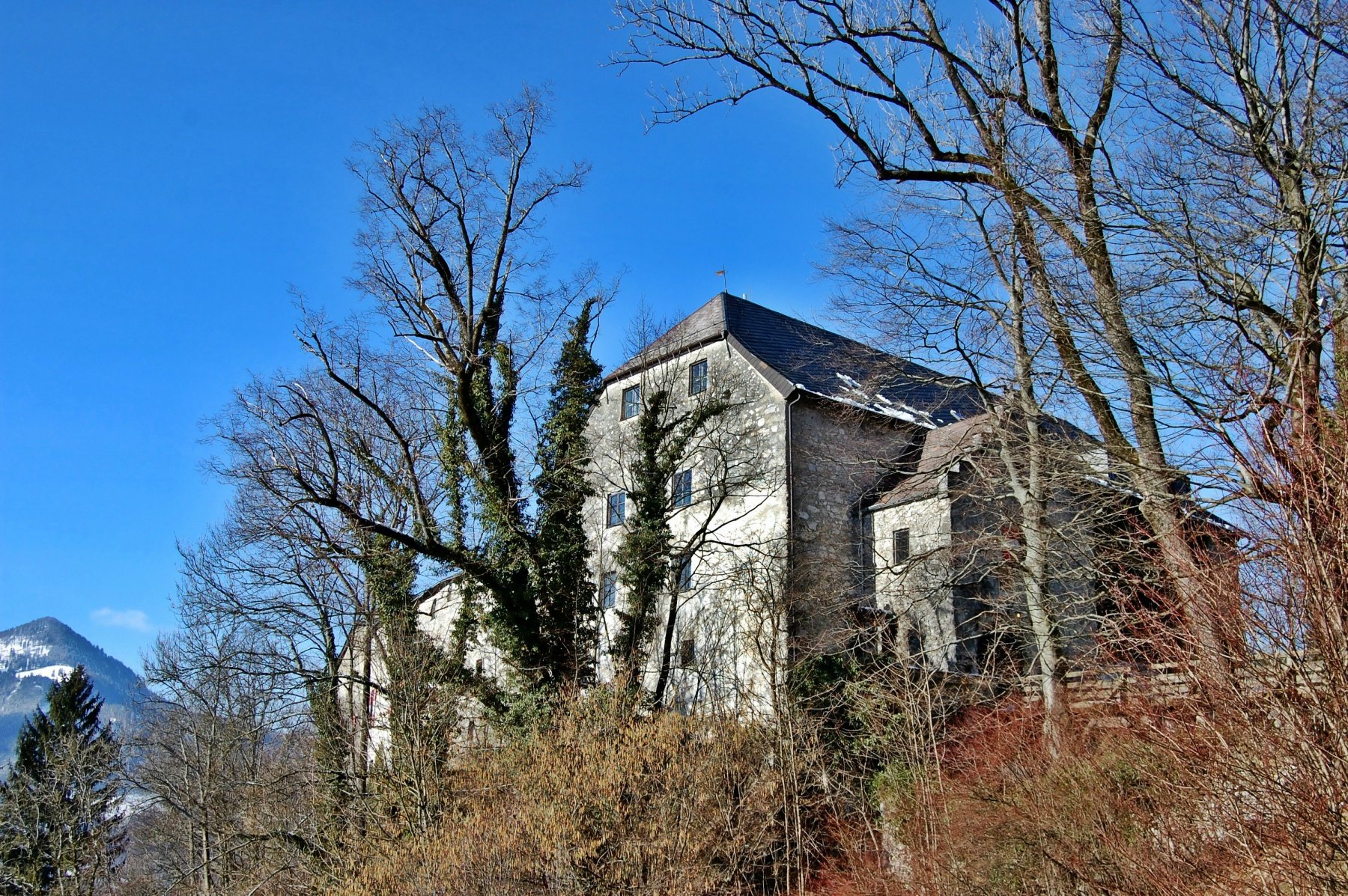 Jetzt mit Blick auf die Burg.
Jetzt mit Blick auf die Burg.
Taken from the small chapel which sits above the castle, with a view of the castle's drawbridge. 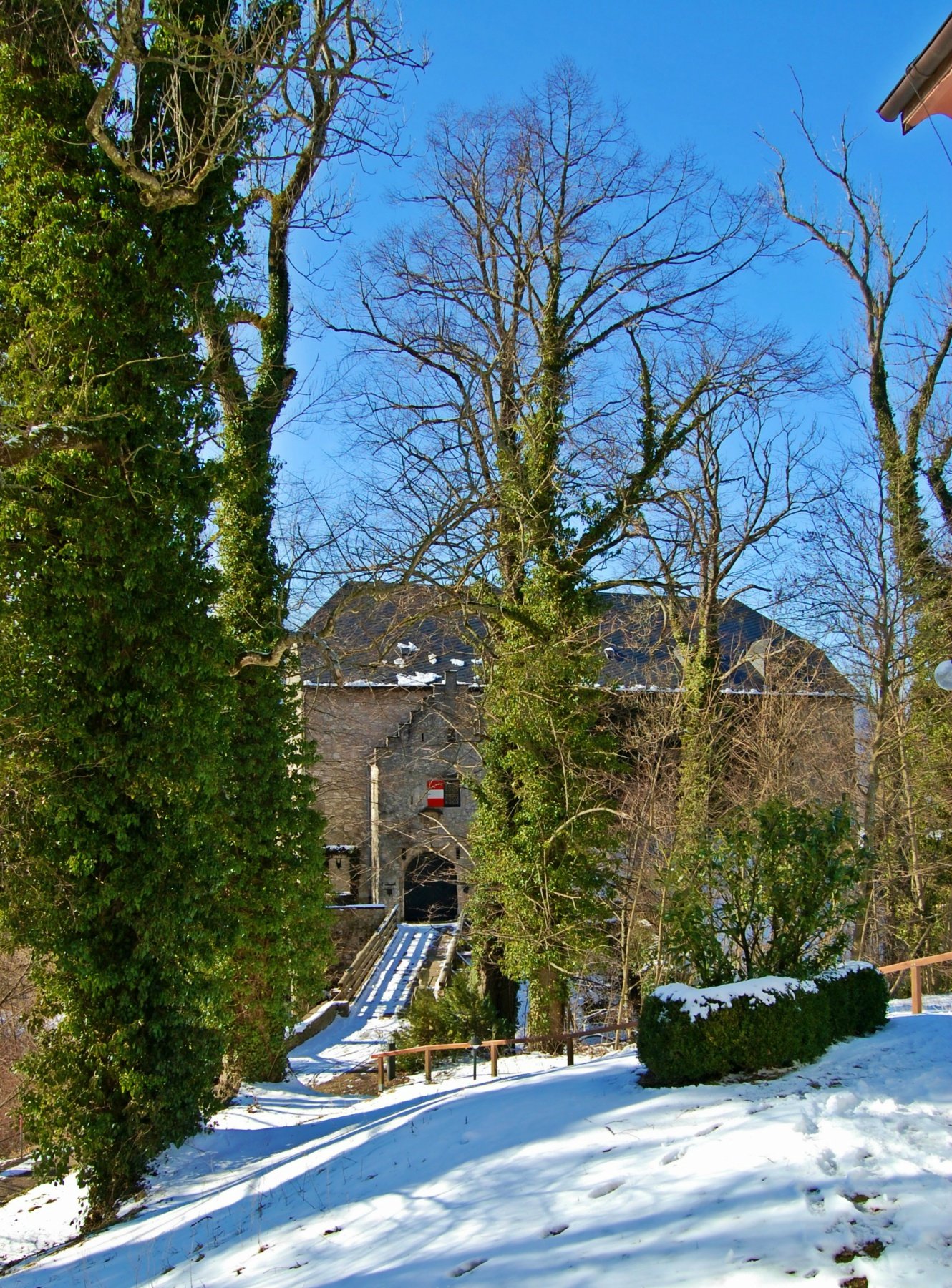 Blick von der kleinen Kapelle oberhalb der Burg mit Blick auf die Zugbrücke der Burg.
Blick von der kleinen Kapelle oberhalb der Burg mit Blick auf die Zugbrücke der Burg.
The Chapel in which Richard Strauss was married. 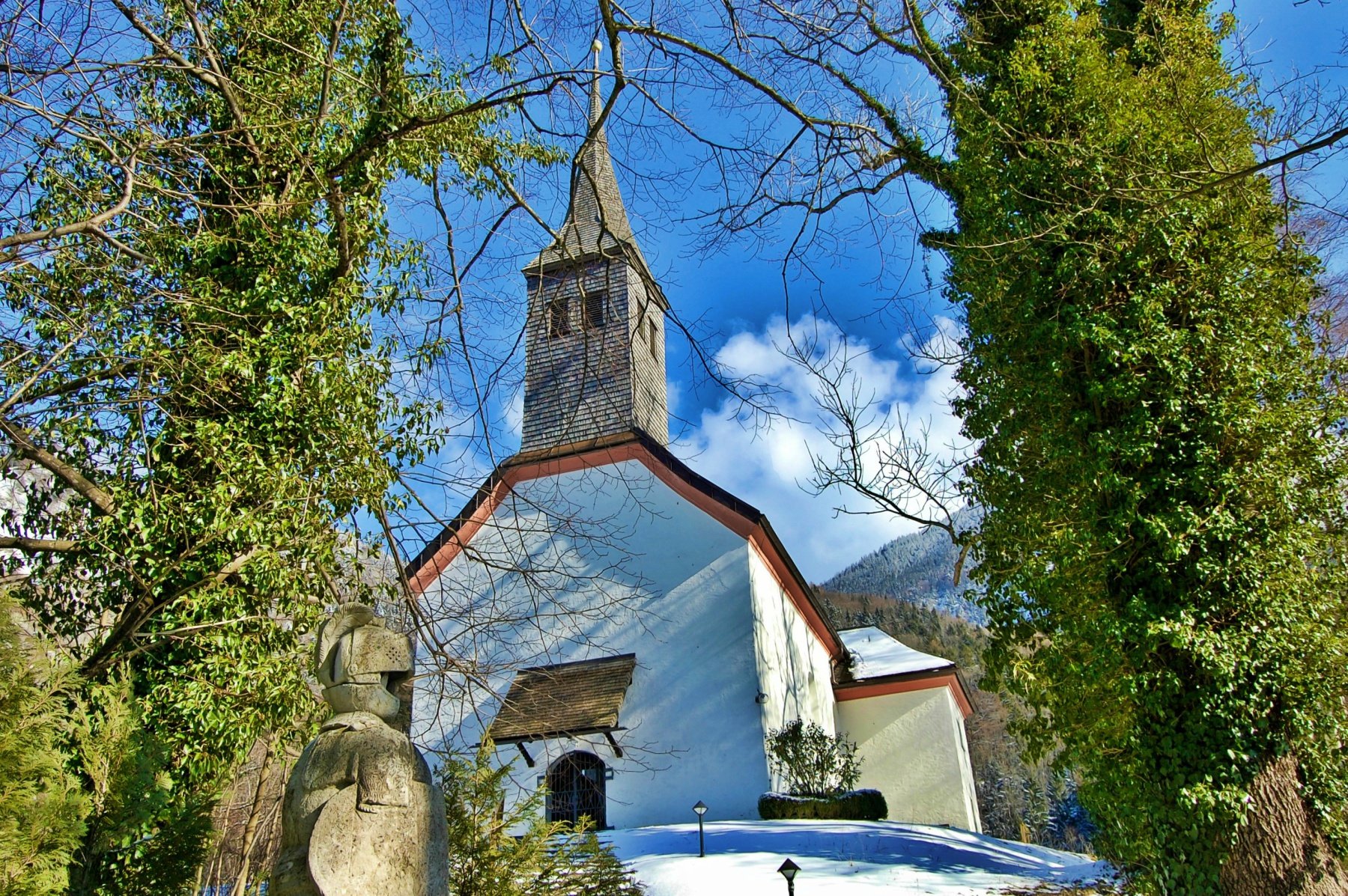 Die Kapelle, in der Richard Strauss getraut wurde.
Die Kapelle, in der Richard Strauss getraut wurde.
I've heard talk that Yo-Yo Ma performed an intimate concert in this chapel. While as a guest at the castle? If so, it's a good guess that he performed music by Richard Strauss.  Ich habe gehört, dass Yo-Yo Ma in dieser Kapelle ein intimes Konzert gegeben hat. Vielleicht als Gast auf der Burg? Wenn dem so ist, ist es gut anzunehmen, dass er Musik von Richard Strauss spielte.
Ich habe gehört, dass Yo-Yo Ma in dieser Kapelle ein intimes Konzert gegeben hat. Vielleicht als Gast auf der Burg? Wenn dem so ist, ist es gut anzunehmen, dass er Musik von Richard Strauss spielte.
Video Inside the Castle / Burg von Innen
Sotheby's Film about the Castle when it was for sale. At about 3 minutes you can see views of the castle.


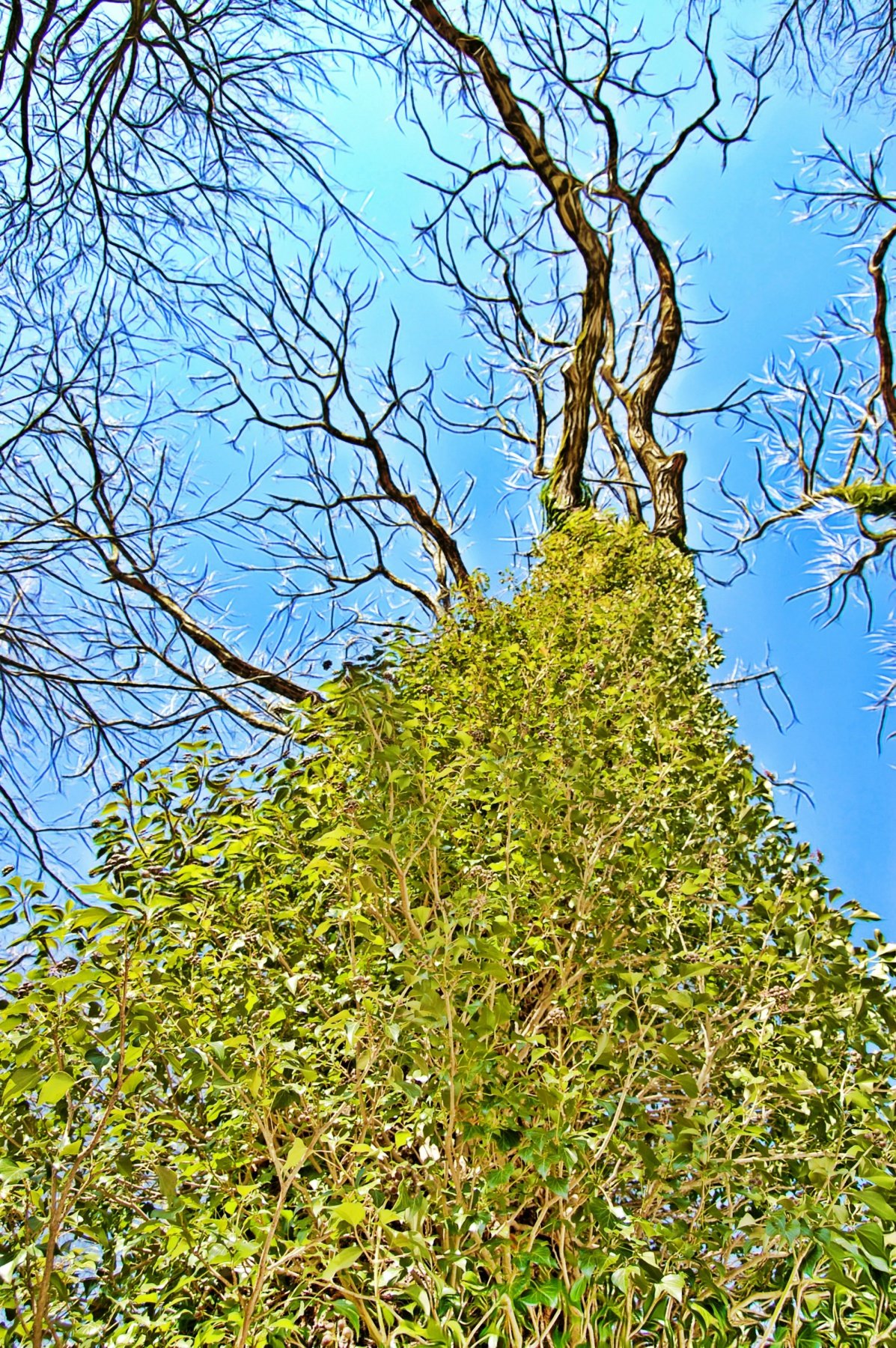

A Few Reflections on my Latest Experiment & Steemit/Steem

Apologies to the German community for my absence this past month. I've been engaged in another one of my experiments, putting all my energy into a single long form post each week. The last four posts were music interviews, and there simply wasn't enough time to transcribe, arrange, edit, and then translate them.
This experiment was only possible thanks to my @sndbox fellowship. Among other things I wanted to demonstrate that the platform has the potential to be more than a blog or social media tool. These interviews were an experiment to drive web traffic to the platform. They were marginally successful, receiving exponentially more views than my typical posts on Steemit. On the other hand, they also received exponentially fewer views than what I'm accustomed to on other platforms.
Normally such long interviews would appear on a popular website that aggregates submissions from various writers. Over time that concentration of content and known level of quality draws visitors. One can imagine that with time steem-based aggregating websites might develop that would function as magazines, television networks, or even music streaming services. The concentrated viewership would lead to increased rewards that would benefit the content creators and also the aggregating sites. I suspect this has the potential to be much bigger than our current collection of blogs.
Even though our platform is an ideal solution for some of the existential challenges musicians face in this new digital world, understandably at this stage there is a stigma attached to a blog vs an established website. Nonetheless, I suspect it is not a question of “if,” but “when” a very popular musician with foresight will recognize the potential of Steem and enthusiastically embrace it -- when that happens it will indeed be a game changer. Passive support from musicians is helpful, but the active participation and engagement of musicians is vital to the viability of such a proposition.
Personally I see one significant obstacle to the development of these aggregating websites on our platform in its current configuration. It is the arbitrarily short life cycle of a post. Imagine if YouTube only monetized videos for 7 days. That seems absurd, and it is. Yet this is our reality, and I fear it will not change.
This short life span of potential rewards has an impact on the viability of the platform and the quality of the content. If this platform achieves mass adoption, the “feed” may fad in significance and become overshadowed by search engine traffic. The bulk of the search engine traffic will occur long after the 7 day life of a post. Content is permanently captured by the blockchain, so why is its value arbitrarily transitory. If a steem driven blog is used to publish an eBook, a video of a self composed song, an original comic book, digital art, photography, etc., why strip the creator of the potential for rewards after a week? Imagine how devastating it would be if something went viral two weeks after it was posted.
Thus Spoke Zarathustra

Ein paar Gedanken zu meinem neuesten Experiment und Steemit / Steem
Entschuldigung an die deutsche Community für meine Abwesenheit im vergangenen Monat. Ich habe wieder eine meiner Experimente durchgeführt. Ich habe jede Woche all meine Energie in einen einzigen langen Post gesteckt. Die letzten vier Beiträge waren Musikinterviews, und es war einfach nicht genug Zeit, um sie zu transkribieren, arrangieren, bearbeiten und dann übersetzen.
Dieses Experiment war nur dank @sndbox möglich, sonst hätte ich niemals so viel Zeit und Mühe in einen einzigen Beitrag für Steemit investieren können. Unter anderem wollte ich zeigen, dass die Plattform mehr als nur ein Blog- oder Social-Media-Tool sein kann. Diese Interviews waren ein Experiment, um zu sehen, ob es einen Weg geben könnte, Web-Traffic auf die Plattform zu lenken. Sie waren marginal erfolgreich und erhielten exponentiell mehr Views als meine typischen Posts auf Steemit. Auf der anderen Seite erhielten sie auch exponentiell weniger Views als ich auf anderen Plattformen erhalte.
Normalerweise würden solche langen Interviews auf einer populären Website erscheinen, die Beiträge von verschiedenen Autoren zusammenfasst. Im Laufe der Zeit zieht diese Konzentration von Inhalten und bekanntem Qualitätsniveau Besucher an. Man kann sich vorstellen, dass mit der Zeit Steem-basierte aggregierende Websites entstehen könnten, die als Zeitschriften, Fernsehsender oder sogar Musikstreamingdienste funktionieren könnten. Die konzentrierte Zuschauerschaft würde zu erhöhten Rewards führen, von denen die Content-Ersteller und auch die aggregierenden Websites profitieren würden. Ich vermute, dass dies das Potenzial hätte, viel größer zu sein als unsere aktuelle Sammlung von Blogs.
Obwohl unsere Plattform eine ideale Lösung für einige der existenziellen Herausforderungen ist, mit denen Musiker in dieser neuen digitalen Welt konfrontiert werden, gibt es für Blogs, was Ansehen betrifft, verständlicherweise einen gewissen Nachteil gegenüber einer etablierten Website. Nichtsdestotrotz vermute ich, dass es nicht eine Frage von "wenn" ist, sondern "wann" ein sehr populärer Musiker mit Weitsicht das Potenzial von Steem erkennt und es enthusiastisch einsetzen wird - wenn das passiert, werden sich die Dinge ändern. Passive Unterstützung von Musikern ist hilfreich, aber die aktive Teilnahme und das Engagement von Musikern ist entscheidend.
Persönlich sehe ich ein signifikantes Hindernis für die Entwicklung dieser aggregierenden Websites auf unserer Plattform in ihrer aktuellen Konfiguration. Es ist der beliebig kurze Lebenszyklus eines Postes. Stell dir vor, dass YouTube nur 7 Tage lang Videos entlohnen würde. Das scheint absurd zu sein, und das ist es auch. Aber das ist unsere Realität, und ich fürchte, es wird sich nicht ändern.
Diese kurze Lebensdauer potenzieller Rewards wirkt sich auf das Potential der Plattform und die Qualität der Inhalte aus. Sollte diese Plattform von den Massen benutzt werden, kann der "Feed" an Bedeutung verlieren und vom Suchmaschinenverkehr überschattet werden. Der Großteil des Suchmaschinen-Traffics wird lange nach dem 7-tägigen Leben eines Beitrags stattfinden. Der Inhalt wird permanent von Blockchain erfasst, also warum ist sein Wert willkürlich flüchtig. Wenn ein Blog, der sich auf Steem stützt, verwendet wird, um ein eBook, einen selbst komponierten Song, ein originales Comic-Heft, digitale Kunst, Fotografie usw. zu veröffentlichen, warum sollte der Schöpfer nach einer Woche die Möglichkeit für Belohnung verlieren? Stell dir vor, wie verheerend es wäre, wenn ein Post zwei Wochen nach der Veröffentlichung Viral gehen würde.
Also sprach Zarathustra

Challenge:
Be the first to find the image Richard Strauss in one of the photos and recieve a surprise.
Challenge:
Sei der Erste, der das Gesicht von Richard Strauss in einem dieser Fotos findet, um eine Überraschung zu bekommen.
Photos
All photos and effects by @roused except the photo of Zoroaster which is from Wikicommons (effects by @roused)



